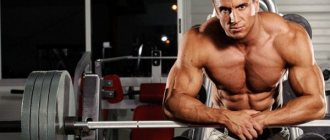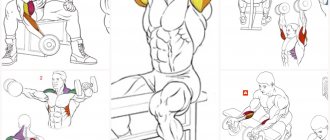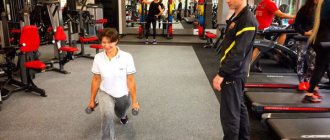Author: Timko Ilya - the ruler of the entire site and fitness trainer | more details >> Rod. 1984 Trained since 1999 Trained since 2007. Author and creator of the site tvoytrener.com. CCM in powerlifting. Champion of Russia and South Russia according to AWPC. Champion of the Krasnodar region according to IPF. 1st category in weightlifting. 2-time winner of the Krasnodar Territory championship in t/a. Author of more than 700 articles on fitness and amateur athletics. Author and co-author of 5 books.
Place in the author rating:
out of competition
(become an author)
Date:
2014-09-28
Views:
42,464
Rating:
5.0
| All articles by the author >> | Medals articles >> |
Articles are loading...
This question is asked to me and the specialists of our site every single day. And the answer is quite simple:
The training program needs to be changed when it stops bringing results.
And this article could end here. Well, what kind of 3-line article is this then? Let's take a closer look.
Now you most likely have the following question: How do you understand that the program has stopped bringing results?
Alas, it’s not so simple here. After all, whether there is a result or not is a very abstract concept. And everyone interprets it in their own way. And the decrease in the effectiveness of the program does not happen overnight.
In general, the average duration of effectiveness of a training plan is approximately two months. Why is this so? It’s just that the practice of many trainers and the centuries-old experience of mankind shows exactly this figure. But this is a very average value. Let's look at three different cases when you need to change your plan.
How often should muscles be shocked?
You may have heard the conversations of old-school gym goers. They are all about “keeping the muscles ignorant” and “the frequency of shocking the muscles.”
In their opinion, you should regularly change your program so that muscle growth does not stop.
Well, to some extent they are right. You need to change your workouts to maintain progress.
But not because of muscular surprise. This is a myth that needs to end.
To some extent, adding variety to your workouts and using some tricks in your exercises is a fairly universal approach to training. But changing the load, number of repetitions and rest time are also important.
In this article, we will look at how often you should change your bodybuilding training programs...
In the periodization of training, several cycles are usually distinguished:
Macrocycle - most often it represents the time required to achieve the final goal, i.e. a specific “intended” state of the body and lasts, as a rule, from six months to a year (but the time period will be individual for everyone). For professional athletes, this period usually coincides with the period of preparation for certain competitions.
A mesocycle is a component of a macrocycle dedicated to achieving one intermediate goal, for example, gaining muscle mass, increasing strength, or reducing the percentage of one of the three types of fat in the body and achieving muscle definition. Most often, such cycles last 2-3 months.
A microcycle is a period of the mesocycle, which also pursues its own specific motives. Typically, the entire microcycle is one training week, during which a different number of training sessions, or, in other words, training sessions, may be expected. During the microcycle, the intensity of training may change, i.e. the amount of weight, the volume of training, which can be measured in the number of approaches or total tonnage, new exercises appear, etc. All this relates to microcycle planning.
The concept of load periodization initially appeared in the training tactics of weightlifters, and only later appeared in bodybuilding and powerlifting. Later the concept spread to fitness. That is why most often they talk about periodization in the context of these sports and, accordingly, mention the goals characteristic of them. But you need to understand that periodization exists in any sport, only its principles will be very different, because different sports areas require the development of different characteristics. So, for example, a marathon runner absolutely does not need to worry about growing muscle mass; his main goal is endurance.
Most likely, most of those who are reading this text now have the same question: “Why do I need to know this?” I fully understand that my audience is not competitive athletes or professional powerlifters. These are people who engage in fitness to maintain health or shape their figure. That is why I will not go into a description of different approaches to periodization of loads. But even if you do fitness “for yourself” and not for the podium, I’m sure you also want to see constant progress and visual results from your classes. That is why you need to “periodize” your training plan.
What might this look like in practice? Let's look at an example and take the most common case. Let's say there is a girl who is 10 kg overweight. She has never been involved in sports or fitness, physical activity is quite difficult for her, but after 6 months she really wants not only to get rid of extra pounds, but also to “acquire” some “shapes” in the buttocks area.
Then it turns out that 6 months is a macrocycle. I would divide this period into 3 mesocycles:
1st - an adaptation period, during which all body systems will adapt to constant loads, and the technique of performing basic exercises will be studied (as a rule, 1 month, a maximum of 1.5 times, will be enough);
2nd - it is better to devote this time to high-quality “working” of muscles against the background of moderate nutrition (2-2.5 months);
3rd - direct reduction in the percentage of body fat and final correction of proportions (respectively, the remaining 2-3 months).
Well, it is clear that a separate training week within each mesocycle will serve as a microcycle.
Immediately anticipating criticism, I want to clarify that the above scheme is simply one of the most common options for solving such a problem and, by no means, the only one. There can be quite a lot of ways to achieve a similar goal, as well as types of training.
Why do you need to know this? In order to understand that it is impossible to achieve everything at once. And if, for example, you have never played sports, come to a trainer and say that in two months you need to go on vacation and by this time you urgently need to lose 15 kg, pump up your “super butt” and it is also advisable to learn how to run 20 km without stopping - this is unlikely. All these are separate stages that require some time for their implementation.
But it is the division of the training plan into intermediate goals that will allow you to reach the final result and, accordingly, avoid the so-called training plateau, during which the body adapts to the type and order of exercises and stops responding to them.
Muscle Building Basics
Regular readers are most likely already familiar with the basics of building muscle mass.
But even the owners of a couple of 50-centimeter biceps and quadriceps on which ordinary pants are cracking can always learn something new.
The bottom line is that nonsense like “shock your body” is just a myth. Muscles have no brain and cannot think for themselves.
You can't walk up to a squat rack, set up for a squat, and then suddenly do a set of dumbbell curls and think you've somehow tricked your arms into growing them faster.
This is simply absurd.
As long as the stimulus is greater than usual, you will continue to gain weight. Forget about gimmicks, nonsense, and tricks like “shocking the muscles.”
But how exactly do you keep the stimulus at the forefront?
Here are the basic principles of gaining muscle mass...
Progressive overload
When you increase the load and lift heavy weights or perform a high-rep set to failure, your body takes you on a journey where it has never been before.
Progressive supercharging for the body means challenging it with something unusual.
Your body is an amazingly smart thing.
When it is challenged on a consistent basis, it adapts. By doing cardio, you develop higher aerobic endurance, and by playing competitive sports, you become more agile.
And if you lift damn heavy weights, your body adjusts, building muscle and getting ripped.
If you use the same weights every workout, your body will eventually not receive enough stimulus to grow muscle.
After some time, your muscle mass will stop increasing altogether.
Just a tip: You need to follow the principle of progressive overload to build muscle.
Sufficient volume
Stimulating muscle growth requires more than just being pumped up or taking a shit ton of tracksuit selfies.
To really build muscle you will need a sufficient amount of exercise.
By volume we mean the total load, which is obtained by multiplying the working weights by the number of approaches and repetitions.
For example:
100 kg bench press with 3*12 reps will give a “load volume” of 3,600 kg.
The greater the volume of the load, the more mass you gain. It doesn't matter by increasing the number of repetitions or using heavier weights.
Just a hint: The higher the load volume, the more growth you will get.
How often should you change your training program? All the truth
If you type the topic of our article today into any search engine, you can get a handful of varied answers. Some say that you need to change your training program often (at least 1-2 times a month), others say that 4 months is the optimal figure, others foam at the mouth and say that six months and no nails! A beginner (and even more so if he is from the outback, where there are no smart coaches and only a couple of gyms in the area) in such a situation only has to guess from the tea leaves what is true and what is false.
And so that the choice is not based on the method of scientific poking, we will deal with the issue based on objective facts and the realities of the ongoing processes.
Why change your training program?
Changing PT is not just a whim, it is a necessity, which is due to completely earthly reasons, namely the desire to constantly progress in:
working scales;
muscle mass;
increasing endurance and strength;
reducing the percentage of subcutaneous fat.
As you know, muscles are not just threads, they are a complex of contractile fibers that are constantly learning and adapting to the load. For them to grow, a person needs to challenge them “uncomfortably”, i.e. one that was not familiar to them until now and which they had not dealt with before. The idea of muscle overload is one of the most important principles of strength training.
When you start lifting new weights or doing new exercises, a time period is created that I call the muscle “honeymoon”. This is when the athlete’s body and his muscles actively respond to a change in load and strive in every possible way to grow and change their initial characteristics (be it strength, time spent under load, etc.). As soon as the sweet month (this does not mean a period of 30 days) passes, the muscles need to be surprised and shocked again, otherwise you can end up on a training plateau. Moreover, you need to surprise not necessarily with heavier weights, but also with a change in quantitative parameters (approaches, repetitions) and also with the use of different Joe Weider principles (pyramid, supersets, etc.).
Note:
The verb to surprise/shock is conditional and introduced to better convey the idea; in fact, muscles cannot be surprised and read about this in the corresponding chapter.
How quickly does the human body adapt to new stress?
The human body is an amazing, reactive adaptive structure. The brain needs 21 days for one or another action repeated day after day to become a habit. Literally a couple of workouts are enough for the muscles, and they are already beginning to adapt to the new operating mode. In particular, the most striking example of the speed of adaptation is when you started doing some new exercise (or came to the gym after a break) and the next morning you cannot move your arm or leg. However, 2-3 training sessions pass and the degree of “impact” on the muscles decreases. In other words, the first 2-4 weeks are the most stressful for the muscles and their most active changes occur, then (from 5 to 8 weeks) there is a slow sliding phase. Ultimately, at 9-12 weeks the muscle stops responding to the training program and (in the middle of this period) it needs new acute sensations :).
This can be visually depicted like this.
How often should you change your training program?
It should be borne in mind that the presented range for changing the training program is flexible. Those. these numbers vary depending on the source material - the degree of training of the athlete. This range is for the average gym/fitness room user. Of course, for beginners (less than 1 year of training experience) the numbers will be higher, because... muscle adaptation to the load proceeds more slowly (the brain-muscle connection is poorly developed) and the “growing” processes extend over a longer period. In other words, the training program for beginners should be changed later by 5-10 weeks (i.e., plus the original numbers).
Experienced athletes who feel their body, they are familiar with advanced training tricks - pumping, different types of muscle contractions, etc., should look towards reducing the time before changing PT. In particular, we can talk about figures of the order of 4-6 weeks within the framework of working with one PT.
In total, the effective time (when the body/muscles are still stimulated to change) of sitting on one training program:
beginners – 10-16 weeks, 2.5-4.5 months;
average – 8-11 weeks, 2-3 months;
advanced level – 4-6 weeks, 1-1.5 months.
Many people, when thinking about changing a training program, take into account only the strength part of it, i.e. aerobic activity remains unchanged. However, it is also necessary to change it, because the body quickly adapts to cardiovascular activity and becomes more energy efficient. Therefore, if the goal of training is to lose weight, then both the strength and cardio parts change.
The body gets used to constant procedures on the treadmill and, having crossed a certain time limit (on average 1-2 months), begins to burn fewer calories than during its first run. The ideal solution that can speed up fat burning processes as much as possible is to quickly change the types of aerobic activity, in particular the following:
week 1 to 3 – swimming;
week 4 to 7 – jumping rope;
week 8 to 11 – sprint.
Note:
Scientists say that as such, the time for the muscle to fully adapt to the load (with the same intensity and volume) occurs already at the 4th workout. All further attempts (5-6, etc. workouts) are supporting actions. Those. the athlete’s muscles begin to reach a training plateau already at the 5th training session and their positive changes (qualitative response to the load) gradually decrease. Further, the further into the forest (more time passes), the more firewood there is (the less advisable it is to sit on a specific PT).
Why don't you need to change your training program? Scientific point of view.
It is often said that the training program needs to be changed frequently to surprise the muscles. This is wrong; it is physiologically impossible to shock the muscles due to their passivity.
In addition, few people know, but each exercise has its own learning curve, a nervous adaptation system (called neural changes in foreign literature). Those. The body adapts to each exercise in its own way, at different times. This “training period” can take from several weeks to several months, depending on the complexity of the exercise and the qualifications of the athlete. To make it clearer what we are talking about, compare two exercises according to the degree of their mastery - biceps curls and deadlifts. The first one is learned quickly, the second one takes much longer.
So, according to the theory of neural adaptation, muscle growth at the initial stage (when the body gets acquainted with a new exercise) is minimal. A serious increase in muscle size occurs only after overcoming the “neural plateau” (neural changes plateau). In this case, plateau does not mean stagnation.
The graph of the study “Neural adaptation to resistance training” (Med Sci Sports Exerc. 1988) looks like this.
change of training program, study schedule
It clearly shows that at first (8-20 weeks) neural (neuromuscular) changes occur in the body and after this period more noticeable muscle growth is observed.
Research findings:
“The increase in peak strength and the rate of its increase are associated with an increase in the nervous system’s ability to recruit muscle fibers into action. Strength training can induce adaptive changes in the nervous system that allow exercisers to more fully activate the primary driving forces in certain movements and better coordinate the recruitment of all relevant muscles, thereby providing greater net force in a given direction of movement. The increase in strength occurs mainly due to improved neural adaptation skills, rather than due to muscle growth.”
Conclusion: if you change exercises every 4-6 weeks, then the body will have very little chance of increasing muscle size. During this time, the body is just beginning to establish neuromuscular connections, and the athlete is already jumping to another exercise (training program). To improve the latter, the training program should always include 2-3 basic exercises for each muscle group. In this case, neural connections are better pumped than if there were single-joint movements in PT.
Another very important point that requires additional explanation is...
Change your training program or weight?
Human muscles are devoid of “thinking”; in this regard, they are passive tissues. They just carry out commands sent from the central nervous system. Therefore, they cannot be deceived; they only perform contractile work - they lengthen and contract. They don’t know what training program you are working on; all they need is a constant progression of the load. If this condition can be ensured (increase the weight slightly) at each (or one) training session, then there is no point in talking about any change in training stimuli (exercises). In other words, the principle of progressive load allows you to sit longer on one PT.
Often, many gym activists begin to change the training program according to the script, i.e. It’s written in the manual after 2 months (or the coach said so), which means I’m changing it. But in fact, he can still easily grow on the current program, simply by systematically observing the principle of load progression. Changing a program at a more advanced level is sometimes caused precisely by the inability to move the weight from a dead point. In this case, the athlete decides to replace the current program with a fresh one.
The standard training scheme for most is split (separation of muscle groups):
training each muscle group once a week;
training each muscle group 2 times a week.
Any of these strategies can effectively build muscle over time, as long as the muscles increase their tension by progressing in working weights. The key to success here is consistency and planning. It is also important to note that by adding weight to the apparatus, in order to increase in volume, it is necessary to increase the number of calories consumed, because each increase in weight requires greater energy expenditure. Therefore, if you are progressing in weight, then do not forget to add calories per day, otherwise the weight will stand still.
Conclusion: Don't discourage muscle growth by changing your training program, but exhaust its full potential by increasing tension.
Three reasons when you 100% need to change your training program
In reality, there are 3 critical reasons when you need to change your current training program.
No. 1. Changing the goal.
If you trained to build muscle mass (for example, autumn-winter) and decided that it’s time to start polishing it (fat burning, muscle definition), then you need to make appropriate changes to the PT.
No. 2. Life circumstances.
Most often, training in the gym is built around a person’s life in the world, and not vice versa. At a young age, people can afford to go to the gym every day. However, over time, a person acquires responsibilities (family, work, children) and it becomes more and more difficult for him to get out to training. In this case, you have to shrink and adjust your PT. Remember this - the moment will come when not only you, but also those whom you have tamed.
No. 3. Rutina Ivanovna.
If you feel that training has ceased to bring pleasure, you carry it out on autopilot and there is zero motivation, then it’s time to change the training program.
Volkova Anna
When should you make changes to your bodybuilding training program?
The bottom line is that you should only change your workout when it no longer feels unusual.
Although the reasons for changing the program can vary, here are the most common ones:
- You don't get stronger, leaner, or gain quality muscle gains;
- You feel tired during the current program;
- Significant loss of energy and overall motivation, in a word, you are bored;
- Your goals have changed and you suddenly decide to run a marathon or do some other crazy thing instead of bodybuilding;
- When changing the phase of training - gaining strength, muscle mass, working on relief - require different schemes and approaches.
When is it necessary to change the program?
In fact, there are 3 main reasons that require a mandatory change to the existing training program.
- Life circumstances . Often life is not built around the gym, but the gym is introduced into the living conditions. If in their youth many people can go to the gym at least every day, then later each person starts a family, begins to build a career and raise children. Then you have to adjust the program taking into account free time.
- Changing the goal . If initially it was necessary to increase muscle mass, and only then it was necessary to remove fat and give relief to the forms, then physically you cannot do without changing the program.
- Boredom . When training stops making you happy and enjoyable, something needs to be changed. Usually the signal is going to the gym “on autopilot” with zero motivation. An excellent option to increase interest in training is to change the program.
The Best Ways to Change Up Your Bodybuilding Workout
So your progress has stopped, you're tired of your current program, or your goals have changed.
How exactly can you change your training program?
Well, depending on the situation.
But here are a few ways to get back on track and resume muscle growth...
Use an advanced training system
When it comes to muscle-building training systems, there are a plethora of options available.
You can dive into cluster sets (rest-pause principle), or even run up to something like isometric exercises that will make you cry when you extend your legs.
You don't even change your training routine - you just add a little special sauce to the exercises you already use.
Don't Rely on Muscle Split
Old school bodybuilders love a good split. Chest on Monday, delts on Wednesday - something like that.
But if you decide to work only one muscle group per workout, you'll soon be left without ideas for specific exercises. You've been doing bent over rows and lat pull-downs for months and you just can't think of other ways to work these muscles.
But full-body workouts not only build more muscle, they also give you more training options. Mainly because you don't have to do as many workouts during the week.
Use repeat loops
Using the period technique, where you change the focus of your training every 4-6 weeks or so, allows you to schedule rep ranges and loads often enough to continue muscle growth.
Rep cycling is a great way to increase progressive overload while still getting the volume of muscle-split work done in the program.
You can perform one month of sets of 4-6 reps with heavy weights, and then for the next month do lighter, high-rep sets of 12-120. You don't even have to adapt your exercises depending on the option you choose.
Replacing exercises
It's not that important to change the exercises you use.
As you can see from the above, there are many productive ways to maintain muscle growth before you need to review your training program and make changes to it.
But choosing exercises can be used as a way to keep things fresh and interesting.
If necessary?
In addition, few people know, but each exercise has its own system of neuromuscular adaptation. Those. The body adapts to each exercise in its own way. Look at how beginners squat (even without weight): their legs tremble, their backs bend, their knees tend to move together. And this is not because their body structure is different from the jocks in the gym. No, their muscles just “don’t know how” to squat!
The training period can take from several weeks to several months depending on the complexity of the exercise . To make it clearer what we are talking about, compare two exercises according to the degree of their mastery - biceps curls and deadlifts . The first one is learned quickly, the second one takes much longer.
So, according to the theory of neuromuscular adaptation, muscle growth at the initial stage, when the body becomes familiar with a new exercise, is minimal. A serious increase in muscle size occurs only after overcoming the “neural plateau” (neural changes plateau).
Look at the graph of the study “Neural adaptation to resistance training” (Med Sci Sports Exerc. 1988). It clearly shows that at first (8-20 weeks) neural (neuromuscular) changes occur in the body and after this period more noticeable muscle growth is observed.
The increase in peak strength and the rate of its increase are associated with an increase in the ability of the nervous system to activate an increasing number of muscle fibers during exercise. Strength training can induce adaptive changes in the nervous system that allow exercisers to more fully activate the primary driving forces in certain movements and better coordinate the recruitment of all relevant muscles, thereby providing greater net force in a given direction of movement. The increase in strength occurs primarily through improved neural adaptation skill rather than through muscle growth .
So stop trying to diversify the program: believe me, working with different weights is quite enough to surprise your muscles. Well, think for yourself, according to this logic, we should abandon basic exercises, “after all, muscles can no longer be surprised by them,” however, there are thousands of examples where people doing only basic exercises for many years grow and remain in great shape. But those who rush from exercise to exercise like a mad flea remain practically in the form with which they began their training.
Few people know about this, but if you do the same exercise not for 6 months, but for several years, then it becomes not just habitual, but familiar, loved, and brings colossal results. Imagine how you will practice your technique in it during this period!
Of course, there is one caveat. It is difficult to train for a long time if the exercise quickly gets boring. Therefore, you can add new isolation exercises for variety. Just never touch the base ! This is your foundation, your bread.
Let's give an example-analogy. American scientists tried to understand what to feed soldiers during the war. In war, soldiers quickly lose weight; it is difficult to force them to eat at all. They were given everything in their travel rations: Mexican cuisine, Italian and other delicacies. At first, the soldiers liked to eat unusual foods. But! Then she quickly got bored. The only thing I didn't get tired of was the bread. All soldiers could eat bread all the time.
Do new exercises “surprise” your muscles? This is true. But! New exercises quickly become boring, and muscles do not grow without well-formed motor skills . A well-formed motor skill is everyday bread, it’s a habit, it’s a favorite exercise. This is a movement ingrained in the memory of the spinal cord. This is what makes muscles grow.
The only thing the muscles respond to is progressive overload , that is, gradually increasing the weights and/or repetitions of a particular exercise over time and periodizing them. You must constantly load your muscles a little more than what they are used to. This is the only way muscles grow. And unlike “muscle surprise,” it’s scientifically proven. Plus, training in the style of taking one step back (controlled relaxation) in order to take two steps forward (controlled stress) will bring you progress and save you from fatigue and injury.
Therefore, all this “pumped up her 100 cm butt with a 20 kg squat and butt swings with weights” is a lie and a provocation: take this lady to an ultrasound of her Madame Sizha, as if you will find something “foreign” there. Butt without squats: is it possible?
Don't worry that monotony will eat you up. Imagine: today we press 50X6/4 (6 reps, 4 sets), next time 50X6/6, then 50X6/8, then 50X8/4, then 50X8/6, at the next workout 50X8/8 - there’s already variety, not a single workout is similar to another. If you want to increase a specific muscle, you don't have to do dozens of different exercises from workout to workout. You need to choose a few exercises and increase the weight and/or repetitions from time to time.
Understand that changing exercises will not speed up your transformation from scumbag to Greek god. Nature does not agree to change you in a few months: burn fat, build muscles, and make your hair thicker. It is more correct to think in terms of “ evolution of the body .” The word “evolution” should be understood as many years of experience.
By the way, many still believe that pain the day after training indicates good work and that you have surprised the muscles enough for their growth. And if suddenly nothing hurts in the morning, something was wrong in the training. Pain is not a sign of muscle growth . It means that your body did something that it is not used to doing, the muscles are in some sense “surprised”, but there is no direct connection with growth.
If you change exercises every 4-6 weeks, then the body will not have time to build a good brain-muscle connection , which is involved in a particular exercise. Think for yourself: the body will only manage to set up this connection, and you will already be jumping to another exercise (training program).
To improve neuromuscular communication, your training program should always include multi-joint exercises for each muscle group. In this case, the neuromuscular connection develops faster than if the training program included only single-joint movements.
Normal figure
For many people, a toned body, or a body that meets fashionable beauty ideals, is not a goal.
Such people train in order to maintain their own health and prevent excessive obesity and any harmful processes in the body.
Therefore, these people may also have a belly and not the most toned limbs, in general, such typical figures of ordinary people, ordinary men and women.
In fact, training programs here should also be changed periodically. At a minimum, in order to have some variety and, along with the body, develop their own neural connections.
If you train according to your chosen program in the gym, vary the scheme every 8-12 weeks, add new main exercises or do not give up the main ones, but include something new in the program.
This way you can get useful supplements and better develop all muscle groups. It is useful to constantly learn in the training process, even if you are not striving for an ideal figure. Working with the body also allows you to work with your own consciousness to develop your personality.
Training program for 4 months
You follow a clearly defined training program, use a training diary, perform basic exercises in the gym, and the results keep growing and growing, then what’s the point of changing it after 1-2 months??? Continue to bomb your muscles to the fullest, using the prepared training schedule, but remember - any program stops working at least 50% after 120 days from the start of classes!
Therefore, after 4 months, change the training program , usually the “flooded” effect stops and stagnation begins, this is where you give the body a shake-up in the form of something new and unusual.
Train wisely, don’t be lazy to change your training program, don’t waste your efforts, it just won’t work here. If anyone doesn’t understand anything, write to me, I’ll be happy to answer. Become muscular Hulks and slender princesses, good luck











